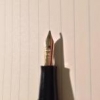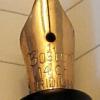Search the Community
Showing results for tags 'nano'.
-
desaturated.thumb.gif.5cb70ef1e977aa313d11eea3616aba7d.gif)
Old retail packaging for Sailor Nano ink cartridges
A Smug Dill posted a gallery image in FPN Image Albums
-
Souboku (蒼墨) is Sailor's new addition this year to its line of pigment inks for fountain pens, after the old stalwarts kiwaguro (極黑) and seiboku (青墨). Since moving to the new, taller square bottles with the smaller footprint, Sailor has dropped the word ‘Nano’ and the hyphens from the names in this product line. Souboku certainly has significantly more black in it than seiboku. I find that it dries to a very pleasant, if sombre, blue-grey colour, but only if it hasn't reached saturation point. It produces shading in distinct steps, almost as if there is a threshold beyond which the ink will dry to a blue-black, and that isn't a particularly good feature in my books. This ink seems to really like to stay together in droplets or globs of itself. Maybe it has an unusually high surface tension? In the convertor, it does not cling to the walls at all, and if there is an air gap between two separated globs of this ink, it is quite difficult to get them to merge and drive out the air bubble. It flows slightly dry, although it has no problem lubricating the point of the nib against the paper surface. On the page, it takes a relatively long time to dry. There is no feathering, no bleed-through and no ghosting on any of the papers (Rhodia 80gsm notepad with perforated pages, Daiso word cards, and Daiso stone paper – all shown in the scan below) on which I've tried writing with the ink. Impressively, some writing on the stone paper stayed wet after 30 minutes, and when I blotted it with a piece of blotting paper (that is coiled around the base of a bottle of Lamy ink), it somehow resisted being all sucked up into its fibres; when I rubbed my finger on the writing afterwards, more ink came off and smeared the tag. That wasn't a matter of it getting wet from the moisture on my fingertips; the ink's water resistance is almost perfect. I put the page under a running tap for 30 seconds, and it did precisely nothing to the writing I wrote with this souboku ink – no discolouration or fading, and no running of colour whatsoever. Someone has mentioned in another thread that the colour is close to Pilot Iroshizuku shin-kai. Well, close, but shin-kai is bluer. I'd say shin-kai is between seiboku and souboku in colour (and flows wetter than both of those Sailor pigment inks). Pelikan 4001 blue-black is blacker (and drier) than souboku. I love the writing experience and the appearance of the output using Sailor souboku ink in my Pilot Metropolitan pen with an F nib. Sadly, I cannot say the same about using it in my Sailor 1911 Large with a Naginata Concord nib; this ink is a little dry for that. All the same, it will probably always have a place in one of my EDC pens. p.s. I soaked the right-hand half of the sheet of Rhodia paper in a cup of water for an hour, and that did precisely nothing to the writing in Sailor souboku ink; it looks the same as it was in the scan above.
-
Okay so I know this sounds strange (or normal for those who have been in the hobby for long enough), but I've received a lot of information regarding pigmented inks which have ended up being quite confusing. The main source of confusion is in its behaviour on paper. I've seen glowing reviews of inks such as Sailor nano inks, Montblanc Permanent Inks and Platinum Carbon ink, but then I've got some more confusing (not contradictory) information regarding the pigmented inks from Rohrer & Klingner regarding their behaviour on paper: bleeding and feathering (at least with flex)? little bleeding and feathering? There is also confusion coming from my own experience: Speedball India ink (don't worry, I used it with a dip pen, no fountain pens were used) spread everywhere, feathered, and bled quite a bit, even on high quality paper such as Clairfontaine, and even cartridge paper. I could only be *salvaged* when I went to dilute it, and only ended up behaving when I had made it a 6:1 water:ink solution, producing a very sad, light grey. Rohrer & Klingner Sepia Calligraphy ink ended up misbehaving too, though it was slightly better than the Speedball. May I please get some clarification on why this is?
- 6 replies
-
- feathering
- bleeding
-
(and 3 more)
Tagged with:
-
To me, Sailor Kiwa-Guro is a remarkable ink because it has a very subtly grainy writing feel which offers me much more control on super-smooth nibs. Also it reduces the line width of a pen without making the pen appear dry or unpleasant. I adore that. I am in awe of that. In terms of colour, it's a very interesting shade of black but it's still black and I'm not big on black ink. So I'm very tempted to buy Sou-Boku, but I'm hoping that Sou-Boku is the same as Kiwa-Guro except for its colour. Is it? Or is it also different in other aspects such as wetness, feel...? Thanks.
-
( I'm not sure in which forum subsection this post rightly belongs, when it is: • not a review of Sailor seiboku pigment ink; and • not comparing seiboku against any other ink. ) After @crahptacular clued me in (thanks!) that the relatively wide range of colours that I elicited from Sailor souboku is related to the idea of 'dryness' of nibs and inks, and it occurred to me that it is not unlike the phenomenon of shading but elicited using multiple nibs over different lines of writing, I set out to identify the 'standard' ink review equipment I would use to show the variation in appearance of a particular ink that is possible from especially fine nibs, which as a category are my personal preference for writing by hand. To that end, I tested the bunch of cheap Japanese desk pens I bought recently, after being inspired by LizEF's question, for different degrees of 'wetness' hoping to find two or more that lay down similar line widths but show distinctively different colours from an ink. Outside of Iroshizuku asa-gao and Diamine Sherwood Green, I have also tested Sailor seiboku, chosen for its kinship with Sailor souboku and the trouble I had with using it in my Sailor Pro Gear with a 21K F nib. These are scans of the results. I've marked with an asterisk❋ the instances in which I used a nib for dipping only without attaching a converter or cartridge to the feed. Just like with Sailor souboku, there is quite a range of colours differing by intensity/saturation on the page. Having tested with three different inks, I have found no agreement as to whether using a converter to feed the nib – after suitably draining/drying it with a thirsty paper towel, then attaching the converter to the nib, and use the paper towel again to help draw ink through and prime the nib for writing – results in 'wetter' writing than by dipping the nib. With Sailor seiboku (shown above), converter-fed writing is noticeably 'drier' than with a dipped nib, particularly with the three Platinum desk pens; the Sailor and Pilot desk pens were not as significantly affected.With Diamine Sherwood Green, converter-fed writing is slightly 'drier' than with a dipped nib, but the differences are not as pronounced.With Iroshizuku asa-gao, converter-fed writing is noticeably 'wetter' than with a dipped nib, and I can see it in all of the Sailor and Platinum desk pens tested. (I didn't use a converter with the M-nibbed Pilot to test that.)At this point I'm inclined to conclude that: The Sailor 11-0073-120 desk pen, used with or without a converter attached, is a fit representation of a (moderately) 'wet' EF-nibbed pen.The Platinum DPQ-700A with EF nib, when used as a dip pen, writes 'drier' than the Sailor.The Platinum DP-1000AN with EF nib, when used as a dip pen, writes even 'drier' than that.and: The Platinum DP-1000AN with F nib, when used as a dip pen, writes significantly 'wetter' (more than merely laying down thicker lines) than the Sailor, judging by the intensity of the colour and relative lack of shading in the writing samples produced with it.The Pilot P-DPP-1S-BM with M nib, when used as a dip pen, approximates a slightly 'drier' writer that lays down similar line widths as the F-nibbed Platinum.By the way, the Sailor 11-0073-120 has the scratchiest nib by a long shot among all my desk pens, and if I manage to get a relatively smooth writing experience with it using a particular ink, I think that would attest to the ink's lubricating capability.

.jpg.91bd353757a432edfe4510496217dc23.jpg)

